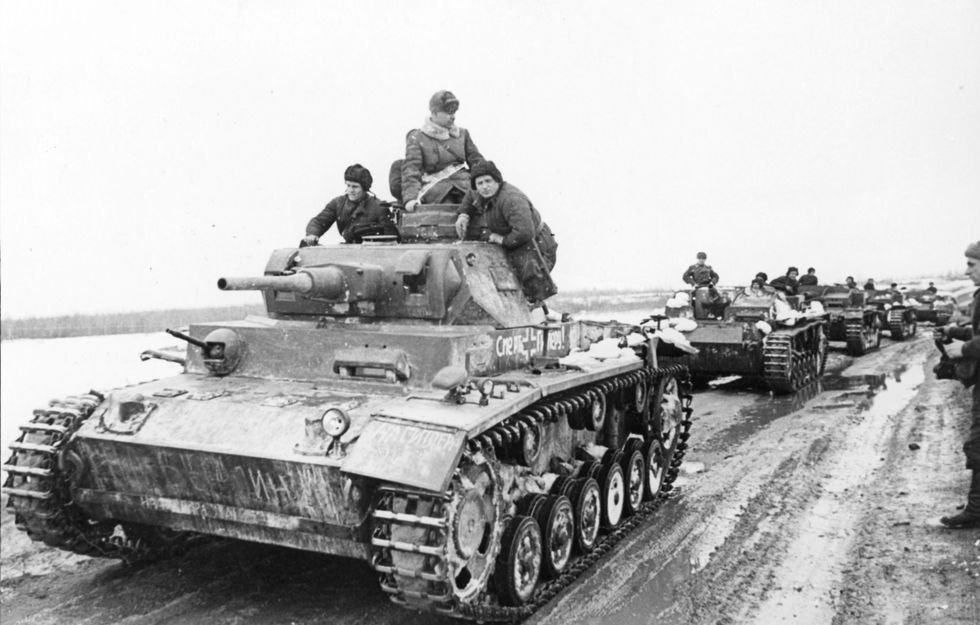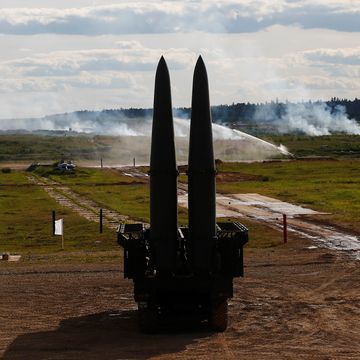One hundred years ago today, on September 15th 1916, German soldiers looked out over the tops of their trenches and got a tremendous shock. Giant metal-covered vehicles, as large as a barn, were slowly advancing towards their position, moving forward in a caterpillar-like motion and spitting cannon and machine gun fire as they came. It was like nothing they'd ever seen before. This was the battle of Flers-Courcelette, and the age of the tank had arrived.
The tank was invented to break the stalemate of trench warfare on World War I's European battlefields. Artillery and machine guns, plentiful on both sides, were particularly effective against the main form of offense—the infantryman. As a result the defense was stronger than just about anything that could be thrown against it, so much so that infantrymen spent most of their time cowering in trenches and bunkers. When the infantry did attack, they would often outstrip their supporting machine gun fire, leaving them vulnerable to counterattacks.
Enter the tank. Designed to swing the pendulum back, the tank was destined to make the offense stronger than the defense and accompany the infantry in the attack, bringing along protected machine guns and cannons that would later be used to beat back the inevitable enemy counterattack.
The first tank, the British Army's Mark I, had a maximum speed of 3.7 miles an hour, a crew of eight, two six-pounder guns—meaning they fired high explosive shells weighing six pounds—and three Hotchkiss 8mm machine guns. This was enough to support an infantry attack in motion, and then provide a mobile fortification after a successful defense. They were notoriously unreliable, with about half of them breaking down at Flers-Courcelette. And while the finicky new machines of war were not quite enough to help Allies win the day decisively, they were fearsome enough that Allied commanders requested 1,000 more, cementing the tank's place on the battlefield.
Over the past one hundred years the tank has evolved by leaps and bounds, particularly during wartime. Today the British Army's main tank, the Challenger II, weighs 70 tons—two and a half times the weight of the Mark I. With a top speed of 37 miles an hour, the Challenger II can travel ten times as fast as its earliest ancestor. It has just one gun, what would probably be called a "42 pounder," a 120-millimeter beast that can destroy other tanks at ranges of 9,800 feet or more. The Challenger II also has two machine guns, and all operated by a crew of just four, half that of the Mark I.
How tanks are used on the battlefield has also changed. While the Mark I was used to help infantry attack and hold gained ground, tanks today generally operate as part of a fast-moving mechanized battle force, capable of fast-moving, deep attacks into the enemy rear. Infantry have evolved to keep up with the tank, riding in their own fast, heavily protected fighting vehicles.
Where might tanks go in the next hundred years? Tanks are locked in an existential arms race with anti-tank weapons, which means the future might mean taking a few steps back. Tanks will likely become lighter, reversing the trend of heavier tanks, making up for the difference in armor protection by incorporating active protection systems that shoot down enemy rockets and missiles. The presence of battlefield sensors in both other tanks, aircraft, drones and even satellites will probably mean tanks will gain optical camouflage and anti-radar stealth.
Tanks will also undoubtedly become more lethal. Railguns and lasers will almost certainly make their way onto tanks, but not until engineers solve the problem of generating and storing the enormous amounts of power both require. Tanks may begin carrying their own micro-drones, capable of flying out over the battlefield, locating enemy forces, and marking them for destruction with the tank's laser-guided shells or missiles.
In other words, tanks may some day begin to resemble submarines on land. That's quite a departure from the days of giant, slug-like, totally conspicuous vehicles lumbering across the barren battlefields of World War I.
But the future is hard to predict. In 2011, the Netherlands got rid of all of its tanks, believing that the age of tank vs tank warfare had ended. Then, three years later, Russian tanks rolled into the Ukraine, and the Dutch are scrambling to get their tanks back in service.
Like all weapon systems, tanks will eventually give way to something else. But until then, tanks will continue to be the dominant system in land warfare, perhaps even to 2116.

Kyle Mizokami is a writer on defense and security issues and has been at Popular Mechanics since 2015. If it involves explosions or projectiles, he's generally in favor of it. Kyle’s articles have appeared at The Daily Beast, U.S. Naval Institute News, The Diplomat, Foreign Policy, Combat Aircraft Monthly, VICE News, and others. He lives in San Francisco.















